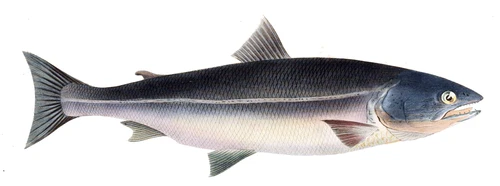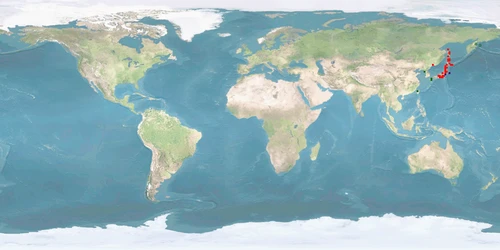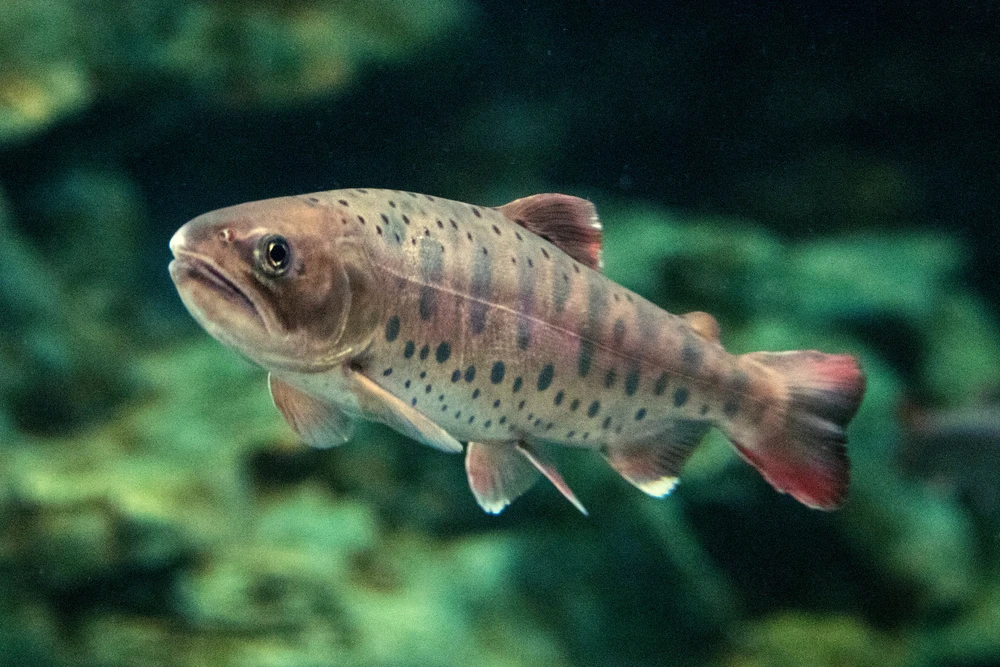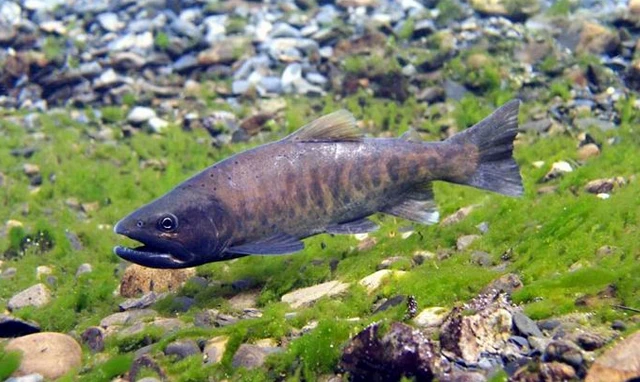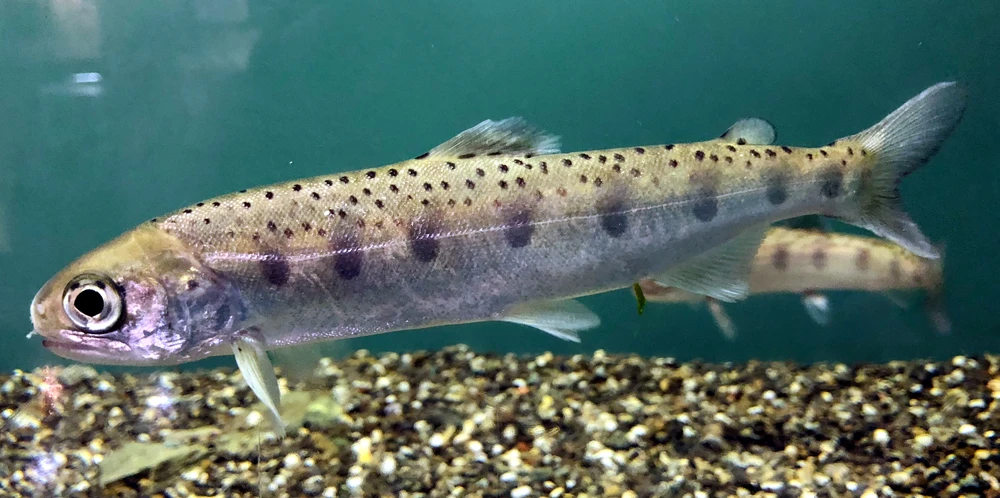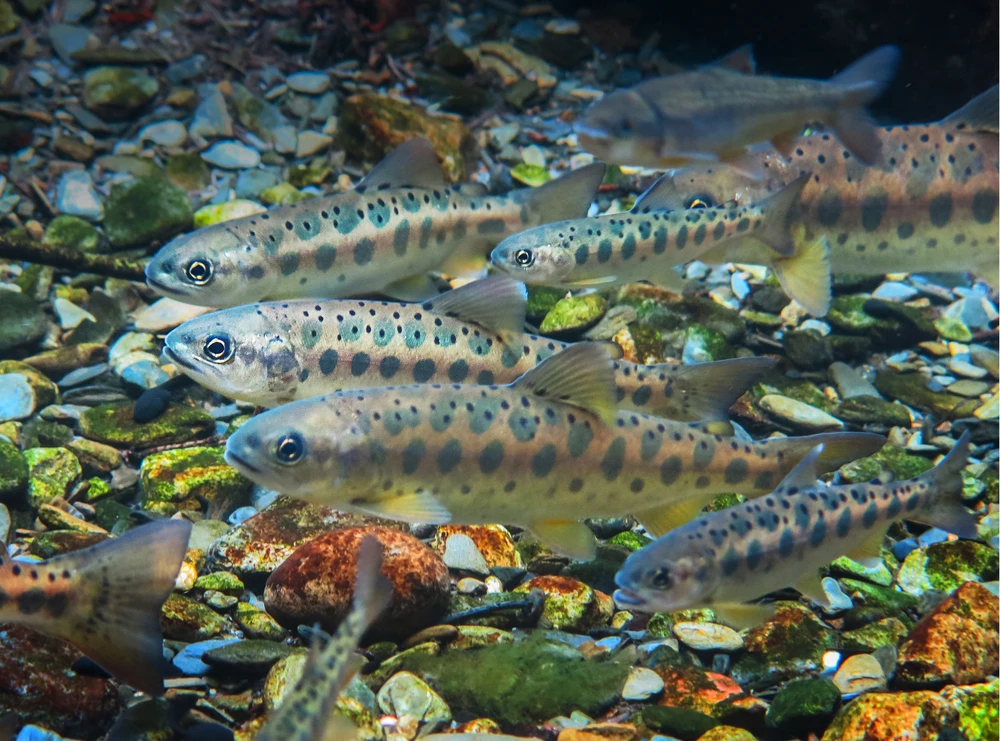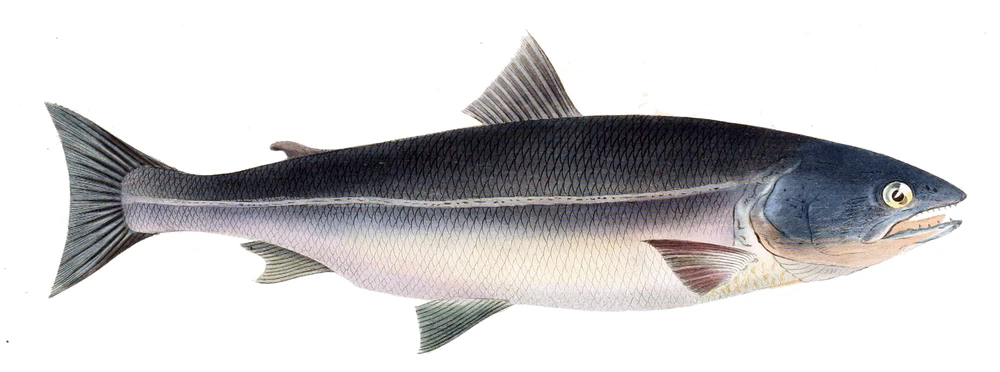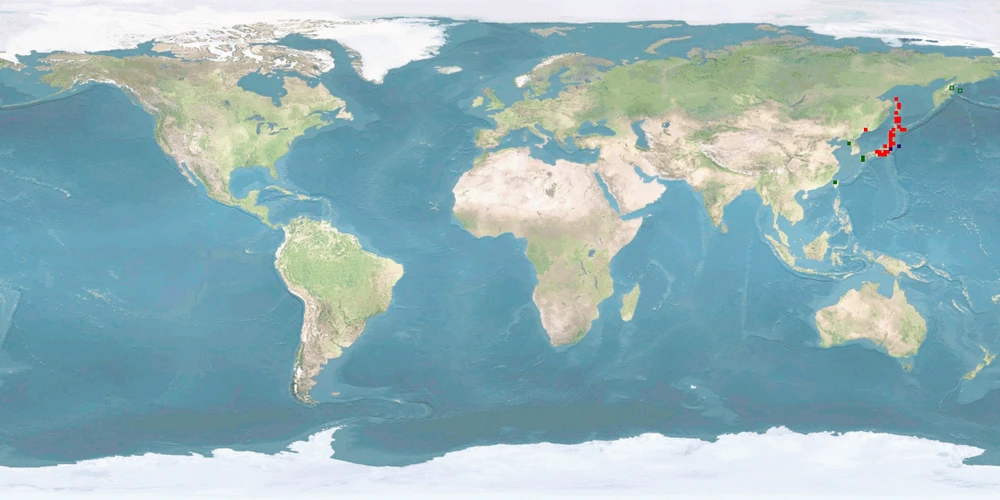Information
Version: B | 1.2 (2024-12-31)
- minor editorial changes (incl. correction of domestication level) plus new side note "Commercial relevance"
WelfareScore | farm
Condensed assessment of the species' likelihood and potential for good fish welfare in aquaculture, based on ethological findings for 10 crucial criteria.
- Li = Likelihood that the individuals of the species experience good welfare under minimal farming conditions
- Po = Potential of the individuals of the species to experience good welfare under high-standard farming conditions
- Ce = Certainty of our findings in Likelihood and Potential
WelfareScore = Sum of criteria scoring "High" (max. 10)
General remarks
The production of Oncorhynchus masou has emerged over the past decades mainly to supplement wild populations and increase fisheries. The low WelfareScore is mainly due to home range needs, high levels of aggression, needs of substrate, stress under farming conditions, and high levels of deformations.
Despite the availability of many studies about the life history and environmental conditions of Salmonids in general, there is limited information on present farming conditions of Oncorhynchus masou. Further research is needed on both natural behaviour and physiological effects of farming practices in order to provide recommendations for improving fish welfare. In addition, the impact of releasing captive IND in the dynamic of the wild populations needs clarifications in order to use the restocking programmes more appropriately and effectively.
1 Home range
Many species traverse in a limited horizontal space (even if just for a certain period of time per year); the home range may be described as a species' understanding of its environment (i.e., its cognitive map) for the most important resources it needs access to.
What is the probability of providing the species' whole home range in captivity?
It is unclear for minimal farming conditions. It is medium for high-standard farming conditions. Our conclusion is based on a medium amount of evidence.


2 Depth range
Given the availability of resources (food, shelter) or the need to avoid predators, species spend their time within a certain depth range.
What is the probability of providing the species' whole depth range in captivity?
It is unclear for minimal farming conditions. It is medium for high-standard farming conditions. Our conclusion is based on a medium amount of evidence.


3 Migration
Some species undergo seasonal changes of environments for different purposes (feeding, spawning, etc.), and to move there, they migrate for more or less extensive distances.
What is the probability of providing farming conditions that are compatible with the migrating or habitat-changing behaviour of the species?
It is low for minimal and high-standard farming conditions. Our conclusion is based on a high amount of evidence.


4 Reproduction
A species reproduces at a certain age, season, and sex ratio and possibly involving courtship rituals.
What is the probability of the species reproducing naturally in captivity without manipulation of these circumstances?
It is unclear for minimal and high-standard farming conditions. Our conclusion is based on a low amount of evidence.


5 Aggregation
Species differ in the way they co-exist with conspecifics or other species from being solitary to aggregating unstructured, casually roaming in shoals or closely coordinating in schools of varying densities.
What is the probability of providing farming conditions that are compatible with the aggregation behaviour of the species?
It is unclear for minimal farming conditions. It is medium for high-standard farming conditions. Our conclusion is based on a low amount of evidence.


6 Aggression
There is a range of adverse reactions in species, spanning from being relatively indifferent towards others to defending valuable resources (e.g., food, territory, mates) to actively attacking opponents.
What is the probability of the species being non-aggressive and non-territorial in captivity?
It is low for minimal and high-standard farming conditions. Our conclusion is based on a medium amount of evidence.


7 Substrate
Depending on where in the water column the species lives, it differs in interacting with or relying on various substrates for feeding or covering purposes (e.g., plants, rocks and stones, sand and mud, turbidity).
What is the probability of providing the species' substrate and shelter needs in captivity?
It is unclear for minimal farming conditions. It is medium for high-standard farming conditions. Our conclusion is based on a medium amount of evidence.


8 Stress
Farming involves subjecting the species to diverse procedures (e.g., handling, air exposure, short-term confinement, short-term crowding, transport), sudden parameter changes or repeated disturbances (e.g., husbandry, size-grading).
What is the probability of the species not being stressed?
It is low for minimal farming conditions. It is medium for high-standard farming conditions. Our conclusion is based on a medium amount of evidence.


9 Malformations
Deformities that – in contrast to diseases – are commonly irreversible may indicate sub-optimal rearing conditions (e.g., mechanical stress during hatching and rearing, environmental factors unless mentioned in crit. 3, aquatic pollutants, nutritional deficiencies) or a general incompatibility of the species with being farmed.
What is the probability of the species being malformed rarely?
It is unclear for minimal and high-standard farming conditions. Our conclusion is based on a low amount of evidence.


10 Slaughter
The cornerstone for a humane treatment is that slaughter a) immediately follows stunning (i.e., while the individual is unconscious), b) happens according to a clear and reproducible set of instructions verified under farming conditions, and c) avoids pain, suffering, and distress.
What is the probability of the species being slaughtered according to a humane slaughter protocol?
It is low for minimal farming conditions. It is medium for high-standard farming conditions. Our conclusion is based on a medium amount of evidence.


Side note: Domestication
Teletchea and Fontaine introduced 5 domestication levels illustrating how far species are from having their life cycle closed in captivity without wild input, how long they have been reared in captivity, and whether breeding programmes are in place.
What is the species’ domestication level?
DOMESTICATION LEVEL 140, level 5 being fully domesticated.
Side note: Forage fish in the feed
450-1,000 milliard wild-caught fishes end up being processed into fish meal and fish oil each year which contributes to overfishing and represents enormous suffering. There is a broad range of feeding types within species reared in captivity.
To what degree may fish meal and fish oil based on forage fish be replaced by non-forage fishery components (e.g., poultry blood meal) or sustainable sources (e.g., soybean cake)?
All age classes: WILD: carnivorous 41. FARM: no data found yet on replacement of fish meal and fish oil by non-forage fishery components.
Side note: Commercial relevance
How much is this species farmed annually?
69 t in 2022 42.
Glossary
ALEVINS = larvae until the end of yolk sac absorption
ANADROMOUS = migrating from the sea into fresh water to spawn
DOMESTICATION LEVEL 1 = first trials of acclimatisation to the culture environment 40
FARM = setting in farming environment or under conditions simulating farming environment in terms of size of facility or number of individuals
FRY = larvae from external feeding on
IND = individuals
PARR = juvenile stage in rivers
SMOLTS = juvenile stage migrating to the sea
SPAWNERS = adults during the spawning season; in farms: adults that are kept as broodstock
WILD = setting in the wild
Bibliography
2 McCormick, Stephen D, Lars P Hansen, Thomas P Quinn, and Richard L Saunders. 1998. Movement, migration, and smolting of Atlantic salmon (Salmo salar). Canadian Journal of Fisheries and Aquatic Sciences 55: 77–92. https://doi.org/10.1139/d98-011.
3 Nakano, Shigeru. 1995. Individual Differences in Resource Use, Growth and Emigration Under the Influence of a Dominance Hierarchy in Fluvial Red-Spotted Masu Salmon in a Natural Habitat. Journal of Animal Ecology 64: 75–84. https://doi.org/10.2307/5828.
4 Miyakoshi, Y., H. Hayano, H. Omori, M. Nagata, and J. R. Irvine. 2002. Importance of instream cover for young masu salmon, Oncorhynchus masou, in autumn and winter. Fisheries Management and Ecology 9: 217–223. https://doi.org/10.1046/j.1365-2400.2002.00300.x.
5 Nakano, S. 1994. Variation in agonistic encounters in a dominance hierarchy of freely interacting red-spotted masu salmon (Oncorhynchus masou ishikawai). Ecology of Freshwater Fish 3: 153–158. https://doi.org/10.1111/j.1600-0633.1994.tb00017.x.
6 Nagata, M., H. Omori, and Yanai, S. 2002. Restoration of spawning and rearing habitats for masu salmon, Oncorhynchus masou in a channelized stream 68.
7 Mighell, James. 1978. The marine net-pen culture of Chery or Masu salmon, Oncorhynchus Masou, and two hybrid crosses in Puget Sound, Washington.
8 Yamamoto, T., and U. Reinhardt. 2003. Dominance and predator avoidance in domesticated and wild masu salmon Oncorhynchus masou.
9 Miyakoshi, Y., T. Takami, K. Takeuchi, H. Omori, M. Nagata, and J. R. Irvine. 2003. Sampling of masu salmon, Oncorhynchus masou, spawners on the spawning grounds: is carcass sampling effective as a mark–recovery method? Fisheries Management and Ecology 10: 273–275. https://doi.org/10.1046/j.1365-2400.2003.00344.x.
10 FAO. 2017. FAO Fisheries & Aquaculture - Species Fact Sheets - Oncorhynchus masou (Jordan & Oshima, 1919). World Wide Web electronic publication. www.fao.org.
11 Yamada, Hiroyuki, and Futoshi Nakamura. 2009. Effects of fine sediment accumulation on the redd environment and the survival rate of masu salmon (Oncorhynchus masou) embryos. Landscape and Ecological Engineering 5: 169–181. https://doi.org/10.1007/s11355-009-0065-8.
12 Nakano, Shigeru. 1995. Competitive interactions for foraging microhabitats in a size-structured interspecific dominance hierarchy of two sympatric stream salmonids in a natural habitat. Canadian Journal of Zoology 73: 1845–1854. https://doi.org/10.1139/z95-217.
13 Yamauchi, Kohei, Masatoshi Ban, Noboru Kasahara, Takayuki Izumi, Hiroshi Kojima, and Tamotsu Harako. 1985. Physiological and behavioral changes occurring during smoltification in the masu salmon, Oncorhynchus masou. Aquaculture 45. Salmonid Smoltification II: 227–235. https://doi.org/10.1016/0044-8486(85)90272-8.
14 Tamate, T., and K. Maekawa. 2000. Life cycle of masu salmon (Oncorhynchus masou) in Shumarinai Lake, northern Hokkaido, Japan. Eurasian Journal of Forest Research 1: 39–42.
15 Koyama, Tatsuya, Mitsuhiro Nagata, Yasuyuki Miyakoshi, Hirofumi Hayano, and James R. Irvine. 2007. Altered smolt timing for masu salmon Oncorhynchus masou resulting from domestication. Aquaculture 273. Smolt 2005: Proceedings of the 7th International Workshop on Salmonid Smoltification: 246–249. https://doi.org/10.1016/j.aquaculture.2007.10.006.
16 Munakata, Arimune. 2012. Migratory Behaviors in Masu Salmon (oncorhynchus Masou) and the Influence of Endocrinological Factors.
17 Kasugai, Kiyoshi, Mitsuhiro Nagata, Katsumi Takeuchi, Mitsuru Torao, Yutaka Murakami, Yoshitaka Sasaki, Yasuyuki Miyakoshi, and James R. Irvine. 2016. Migratory timing of masu salmon and Dolly Varden smolts exiting the Uebetsu River near the Shiretoko World Heritage Site, Hokkaido, Japan, and potential angling effects. Ichthyological Research 63: 181–186. https://doi.org/10.1007/s10228-015-0477-4.
18 Watanabe, (primeiro) Takamura, S., and Maekawa, K. 2008. Effects of timing of nest entry and body size on the fertilization success of alternative male reproductive phenotypes of masu salmon (Oncorhynchus masou) - Canadian Journal of Zoology 86: 1121–1130.
19 Kubo, Tatsuro. 1980. Studies on the Life History Of the “Masu” Salmon {Oncorhynchus masou) in Hokkaido. Hatchery Field Research Report No. 34.
20 Fried, Stephen M., James D. McCleave, and George W. LaBar. 1978. Seaward Migration of Hatchery-Reared Atlantic Salmon, Salmo salar, Smolts in the Penobscot River Estuary, Maine: Riverine Movements. Journal of the Fisheries Research Board of Canada 35: 76–87. https://doi.org/10.1139/f78-011.
21 Riley, W. D., A. T. Ibbotson, D. L. Maxwell, P. I. Davison, W. R. C. Beaumont, and M. J. Ives. 2014. Development of schooling behaviour during the downstream migration of Atlantic salmon Salmo salar smolts in a chalk stream. Journal of Fish Biology 85: 1042–1059. https://doi.org/10.1111/jfb.12457.
22 Dill, Peter A. 1977. Development of behaviour in alevins of atlantic salmon, Salmo salar, and rainbow trout, S. gairdneri. Animal Behaviour 25, Part 1: 116–121. https://doi.org/10.1016/0003-3472(77)90073-2.
23 Blanchet, S., J. J. Dodson, and S. Brosse. 2006. Influence of habitat structure and fish density on Atlantic salmon Salmo salar L. territorial behaviour. Journal of Fish Biology 68: 951–957. https://doi.org/10.1111/j.0022-1112.2006.00970.x.
24 Andersson, Madelene Åberg, Uniza Wahid Khan, Oyvind Overli, Hans Magnus Gjøen, and Erik Höglund. 2013. Coupling between stress coping style and time of emergence from spawning nests in salmonid fishes: evidence from selected rainbow trout strains (Oncorhynchus mykiss). Physiology & Behavior 116–117: 30–34. https://doi.org/10.1016/j.physbeh.2013.03.019.
25 Reinhardt, Ulrich G. 2001. Selection for Surface Feeding in Farmed and Sea-Ranched Masu Salmon Juveniles. Transactions of the American Fisheries Society 130: 155–158. https://doi.org/10.1577/1548-8659(2001)130<0155:SFSFIF>2.0.CO;2.
26 Mingist, M., T. Kitani, N. Koide, and H. Ueda. 2007. Relationship between eyed-egg percentage and levels of cortisol and thyroid hormone in masu salmon Oncorhynchus masou. Journal of Fish Biology 70: 1045–1056. https://doi.org/10.1111/j.1095-8649.2007.01362.x.
27 Erikson, Ulf, Trygve Sigholt, and Aina Seland. 1997. Handling stress and water quality during live transportation and slaughter of Atlantic salmon (Salmo salar). Aquaculture 149: 243–252. https://doi.org/10.1016/S0044-8486(96)01453-6.
28 Øverli, Øyvind, Wayne J. Korzan, Erik Höglund, Svante Winberg, Herbert Bollig, Michael Watt, Gina L. Forster, et al. 2004. Stress coping style predicts aggression and social dominance in rainbow trout. Hormones and Behavior 45: 235–241. https://doi.org/10.1016/j.yhbeh.2003.12.002.
29 Øverli, Øyvind, Christina Sørensen, and Göran E. Nilsson. 2006. Behavioral indicators of stress-coping style in rainbow trout: Do males and females react differently to novelty? Physiology & Behavior 87: 506–512. https://doi.org/10.1016/j.physbeh.2005.11.012.
30 Pottinger, Thomas G. 2006. Context dependent differences in growth of two rainbow trout (Oncorhynchus mykiss) lines selected for divergent stress responsiveness. Aquaculture 256: 140–147. https://doi.org/10.1016/j.aquaculture.2006.01.023.
31 Azuma, Teruo, Shuhei Noda, Takashi Yada, Mitsuru Ototake, Hiroiyuki Nagoya, Shunsuke Moriyama, Hideaki Yamada, Teruyuki Nakanishi, and Munehico Iwata. 2002. Profiles in growth, smoltification, immune function and swimming performance of 1-year-old masu salmon Oncorhynchus masou masou reared in water flow. Fisheries Science 68: 1282–1294. https://doi.org/10.1046/j.1444-2906.2002.00566.x.
32 Taveekijakarn, P., T. Miyazaki, M. Matsumoto, and S. Arai. 1994. Vitamin A Deficiency in Cherry Salmon. Journal of Aquatic Animal Health 6: 251–259. https://doi.org/10.1577/1548-8667(1994)006<0251:VADICS>2.3.CO;2.
33 Romanov, N. S. 1984. Effect of culture conditions on skull morphology in smolts of the masu salmon, Oncorhynchus masou (Brevoort). Aquaculture.
34 Fairgrieve, W. 2009. Cultured Aquatic Species Information Programme. Oncorhynchus kisutch. Rome: FAO Fisheries and Aquaculture Department.
35 LocalCoho Farms. 2021. Personal communication.
36 European Food Safety Authority (EFSA). 2009. Species-specific welfare aspects of the main systems of stunning and killing of farmed Atlantic Salmon. EFSA Journal 7: 1–77. https://doi.org/10.2903/j.efsa.2009.1011.
37 Lambooij, E., E. Grimsbø, J. W. van de Vis, H. G. M. Reimert, R. Nortvedt, and B. Roth. 2010. Percussion and electrical stunning of Atlantic salmon (Salmo salar) after dewatering and subsequent effect on brain and heart activities. Aquaculture 300: 107–112. https://doi.org/10.1016/j.aquaculture.2009.12.022.
38 Lines, J. A., D. H. Robb, S. C. Kestin, S. C. Crook, and T. Benson. 2003. Electric stunning: a humane slaughter method for trout. Aquacultural Engineering 28: 141–154. https://doi.org/10.1016/S0144-8609(03)00021-9.
39 European Food Safety Authority (EFSA). 2009. Species-specific welfare aspects of the main systems of stunning and killing of farmed fish: Rainbow Trout. EFSA Journal 7: 1012. https://doi.org/10.2903/j.efsa.2009.1012.
40 Teletchea, Fabrice, and Pascal Fontaine. 2012. Levels of domestication in fish: implications for the sustainable future of aquaculture. Fish and Fisheries 15: 181–195. https://doi.org/10.1111/faf.12006.
41 Froese, R., and D. Pauly. 2017. Oncorhynchus masou masou summary page. World Wide Web electronic publication. www.fishbase.org.
42 FAO. 2024. FishStat: Global aquaculture production 1950-2022. www.fao.org/fishery/en/statistics/software/fishstatj: FishStatJ.







